The river “flows up the map,” they used to say, first south, then west, and then north, and through some of the most verdant and beautiful country in America. It is called the Tennessee, but it drains some forty thousand square miles of land in seven states, from the Blue Ridge Mountains to Alabama, and from Mississippi to the Ohio River, an area nearly the size of England.
Before the 1930s, it ran wild, threatening each spring to flood and wash away the humble farms and homes along its banks. Most of it was not navigable for any distance, thanks to “an obstructive fist thrust up by God or Devil”—as the writer George Fort Milton characterized it—that created a long, untamed run of rapids known as Muscle Shoals. The fist dropped the river 140 feet over the course of 30 miles, and therein lay the untapped potential of the Tennessee, the chance to make power—a lot of it—out of water.
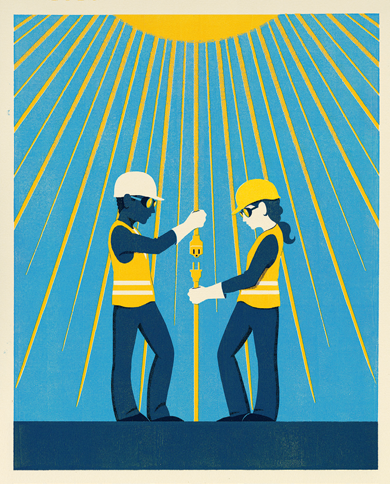
Illustration by Dan Bejar.
The six million people who lived in the Tennessee Valley in 1933 had little power, though, literal or political. At a time when an estimated 70 percent of Americans could have light at the flip of a switch, only 10 percent of rural families throughout the United States had electricity—and a full one quarter of the nation still lived either on farms or in rural communities. Bringing power to the farms just wasn’t worth it, private utility companies insisted. They were too scattered and too poor—and those in the Tennessee Valley were among the poorest to be found anywhere in the country.
The region had been floundering since at least the end of the Civil War, falling further and further behind a rapidly industrializing nation. The local farmers grew cotton or corn, crops that, repeated year after year, leeched the fertility out of the land. To compensate, they bought more fertilizer on credit, falling deeper into debt, unable to afford the modern farm machinery that was transforming agrarian life elsewhere in the country.
In their desperation, the people of the Tennessee Valley had begun to cut or burn down more and more of the area’s once copious forests every year, seeking to clear more marginal land for farming, to sell the timber, or simply to heat their homes and cook their meals. Deforestation only further drained the soil, and what little land they had kept slipping away. While much of urban America was enjoying the boom years of the Roaring Twenties, the average annual income in the Valley had shrunk to just $639 a family, while many made as little as $100. Incredible as it may seem to us today, one third of the people in the Valley suffered from malaria. Malnutrition, pellagra, hookworm, and other parasites were ubiquitous.
In the wider region, according to the historian Sheila D. Collins, “More than 1,300 communities containing 17 million people had no general hospital and lacked even a public health nurse.” Of the children between seven and thirteen years of age, almost a million had no schooling.
The onset of the Great Depression made everything worse. The sons and daughters of the Valley who had moved to local towns and cities, seeking employment in factories and mills, now moved back in large numbers, their jobs gone, putting further pressure on the land. The number of farms doubled, and their size dropped from an average of 139 acres to a barely sustainable 55. The percentage of sharecroppers and tenant farmers tripled, until nearly one family in three was reduced to peonage, working for someone else—working just to live.
Compared with much of America, the people of the Valley seemed to live in a different time. Three quarters of their households had no indoor plumbing. They cooked their meals over wood-burning stoves and fireplaces, read by candlelight and kerosene lamp, washed their clothes by hand over washboards down at the creek.
The region had spiraled into a crisis far worse than even its normal, wrenching poverty. But what was to be done? Life had always gone on this way, just as it had in so many other places of perpetual, implacable poverty, on the southern plains and in the urban slums of New York’s Lower East Side and Hell’s Kitchen; on Indian reservations everywhere; in the fields and the fruit orchards of southern California. Those who were smart enough, ambitious enough, or ruthless enough got out and went somewhere else to make a better life.
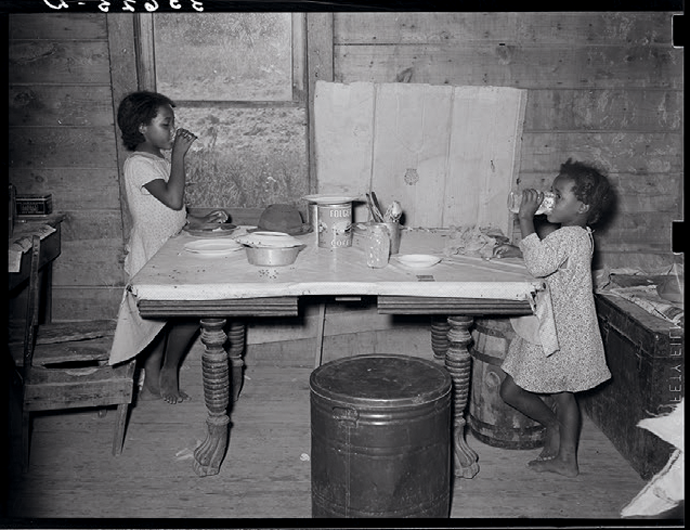
Children of a tenant farmer eat a lunch of bread and flour gravy, Wagoner County, Oklahoma, 1939 © Russell Lee/LC-USF34-033625-D All photographs courtesy the Library of Congress, Prints and Photographs Division, FSA/OWI Collection, unless otherwise noted.
A solution to this crisis was found, even in the worst of times and in the hardest of circumstances, and even though many experts and learned commentators assured us that such a solution would be prohibitively expensive, or intrusive, or unconstitutional, or contrary to everything that was best in our American way of life. It was called the New Deal, but that was just the political rubric for putting into action ideas that many people in America and elsewhere had been advocating for a long time—ideas that showed we didn’t have to go on doing things the old, destructive, senseless way that had brought us to such a state.
Like every other human endeavor, the New Deal did not work perfectly. The men and women who put it into motion made mistakes, and they were not always able to overcome the opposition. They were forced to compromise and improvise and rethink what they were doing. But they made it work. They controlled a seemingly uncontrollable crisis—a series of existential threats, really, in the United States and the wider world—and in so doing they expanded human liberty at a time when so many others were trying to do away with it.
We find ourselves today in much the same place, confronted by an array of emergencies—seemingly disparate, but in fact closely connected—that threatens to destroy us. Braced against them is a set of ideas put forward in a congressional resolution by Alexandria Ocasio-Cortez (the notorious AOC), a twenty-nine-year-old freshman congresswoman, and her young, ad hoc brain trust. They have put into words the growing convictions of many over the years that we cannot go on the way we have been if we are to survive and continue to keep our liberties. It is altogether fitting and proper that this effort has been named the Green New Deal, for it seeks to draw what worked best from the original New Deal and to learn from its mistakes. How well we do in putting its ideas, goals, and promises into effect will determine what our world will be like for a very long time to come.
But I don’t wish to sound so grim about the endeavor. Here is where our new world begins.
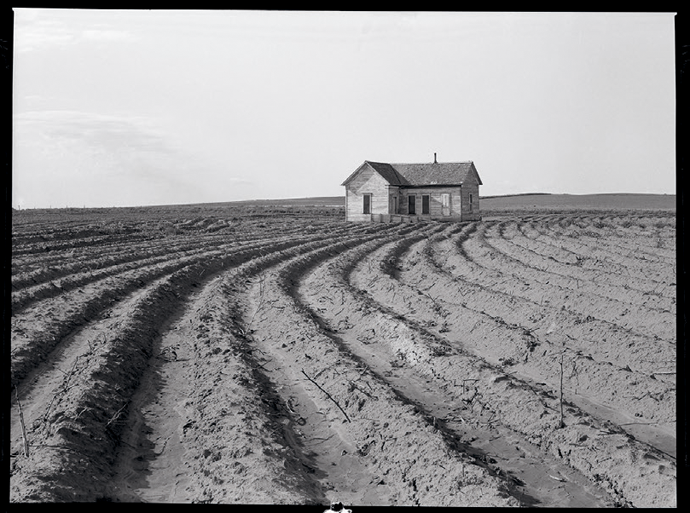
Power farming, Childress County, Texas, 1938 © Dorothea Lange/LC-DIG-PPMSC-00232 |
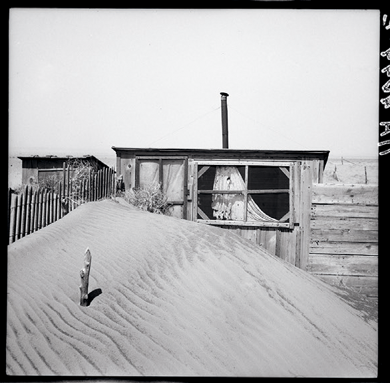
Sand piled up in front of a farm building, Cimarron County, Oklahoma, 1936 © Arthur Rothstein/ LC-DIG-FSA-8b38341 |
The Great Depression in the United States was an environmental collapse every bit as much as it was an economic collapse—“twin peaks of a systemic civilizational crisis of unprecedented but entirely foreseeable and preventable proportions,” as Collins characterized it. It was the end point of how we had always done things. We could see it and feel it and breathe it, all around us.
By the 1930s, five sixths of the original indigenous animal population that existed in the United States when the Europeans arrived had been wiped out. Seven eighths of the original woodlands had been cleared. One sixth of the topsoil in the United States would shortly blow away in the ecological disaster of the Dust Bowl.
The dust storms were very much a man-made disaster, the result of the heedless booms and busts that had succeeded one another for decades on the High Plains. We knew that farming this place was a bad idea—had known for over a century that much of the region we called the Great American Desert did not have enough water to support the crops we wanted to grow. But that didn’t stop us. Much as the Trump Administration and corporate America react today to the idea of climate change or anything else they don’t want to hear by making stuff up, the government and the railroads, in the second half of the nineteenth century, promoted quack theories to serve their purposes. No water? Don’t worry: there was always “dry farming,” “dust mulching,” and the imperishable notion that “rain follows the plow”—or civilization in general.
“The Santa Fe Railroad printed an official-looking progress map, showing the rain line—twenty inches or more, annually—moving west about eighteen miles a year with new towns tied to the railroad,” wrote Timothy Egan in his magisterial history of the Dust Bowl, The Worst Hard Time. “With scientific certainty, steam from the trains was said to cause the skies to weep.”
Unlike the dirt-poor farmers of the Tennessee Valley, the plowmen of the High Plains were able to obtain the latest motorized combines and tractors, thanks mostly to cheap bank loans, and during the wheat booms of the 1920s they used their machines to tear apart the fragile ecosystem of the land around them. As prices kept declining due to the glut of crops they kept producing, they ripped into even more marginal lands, still funded by the local, undercapitalized banks that forked over loans with low interest rates on almost no collateral. Soon they were joined by “suitcase farmers” out from the towns and cities on weekends, looking to “hit a crop” and make some quick cash.
But so what? Americans wanted more bread, and cereal for breakfast—a “need” created largely by the breakfast-cereal companies and the advertising whizzes they hired. Europeans wanted bread, too, since many of their fields had been ruined in the First World War. To supply these needs, US farmers were harvesting bushels of wheat in record amounts—and wrecking much of the countryside.
“The tractors had done what no hailstorm, no blizzard, no tornado, no drought, no epic siege of frost, no prairie fire, nothing in the natural history of the southern plains had ever done,” Egan noted.
They had removed the native prairie grass, a web of perennial species evolved over twenty thousand years or more, so completely that by the end of 1931 it was a different land—thirty-three million acres stripped bare on the southern plains.
Before long, the dust began to blow. There were 14 dust storms in 1932, another 38 the next year, a record 134 in 1937. It is difficult to adequately convey the terror of a dust storm to those of us living today who have never experienced one. You can get some sense of them from the photographs of the time: mountains of darkness closing in on humble Western towns. They barreled along fronts that were hundreds of miles long and could be at least 10,000 feet high; some reached altitudes of over 20,000 feet. It was nearly impossible to run away from a duster, or even to escape it in the fastest conveyances then available. Often moving at up to one hundred miles per hour, they overtook cars and derailed trains. Airplanes fared no better.
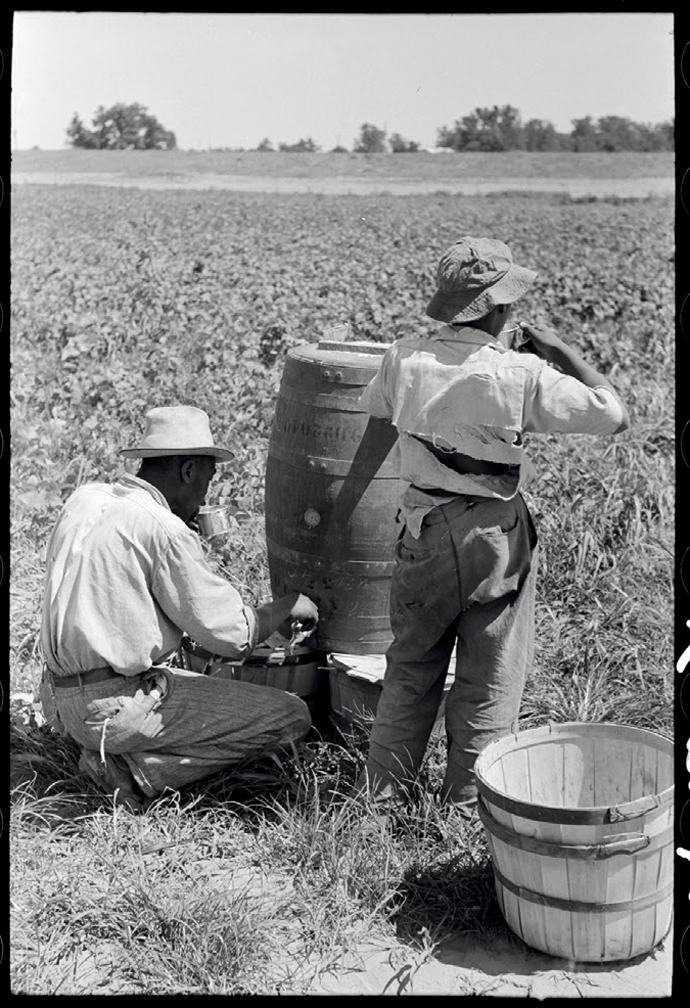
Day laborers in a bean field, near Muskogee, Oklahoma, 1939 © Russell Lee/LC-USF33-012270-M1
The dust storms were not merely blown dirt, frightening as that might seem, but entire weird weather systems marching across the land. The static electricity they generated made fire dance along barbed wire and shorted car ignitions. It electrocuted farm animals and those few crops the blowing dirt had not already smothered—literally blackening vegetables in the patches where they lay. The people in the paths of these storms huddled in the darkness, unable to see their hands before their faces for hours, choking—sometimes choking to death—on the “dust pneumonia” that scarred their lungs as badly as if they had contracted tuberculosis.
There was no natural stopping point to the storms. They traveled for as long and as far as the winds blew—and the winds were fairly constant out on the Great Plains. One Dust Bowl survivor remembered the wind blowing for twenty-seven straight days and nights, one more natural phenomenon to threaten the sanity of those who had to withstand it.
A fresh storm blew up on May 9, 1934, this one out of the freshly turned earth of Montana and Wyoming, an estimated 350 million tons of dirt suddenly airborne. It dropped more than 12 million tons of grit on Chicago, then covered the East Coast from Boston to Savannah. In New York City, it cut the sunlight of a lovely spring day in half for five hours. Nor did it stop there, since there was nothing to stop it. The duster did not dissipate until it had blown over three hundred miles out over the Atlantic Ocean, startling sailors when it rained dirt on the decks of their ships.
In that same year, as William Manchester recounted in his social history The Glory and the Dream, the new National Resources Planning Board estimated that 35 million acres of previously arable land had been completely destroyed, while another 100 million acres would soon be barren and 125 million acres beyond that—altogether the land of 756 counties in nineteen states—had lost nearly all their topsoil.
Without enlightened national leadership, Collins conjectures, we might have faced an even worse environmental catastrophe—that as the crisis worsened, local, piecemeal attempts to fight the despoliation of the land would have only made things worse, until the entire devolving crisis left us at the tipping points of global warming and species destruction. That is, right where we are today.
There was no known plan put forward by anyone in private enterprise—although at least in the 1930s no business lobbying group had the temerity to tell us that the dust storms sweeping over New York and Washington weren’t really happening. Individual suggestions for dealing with the Dust Bowl included littering the Plains with junked cars to hold down the dirt under their rusting metal chassis and simply paving thousands of square miles with asphalt. Congress actually debated ways of trying to alter the flow of water from the Continental Divide.
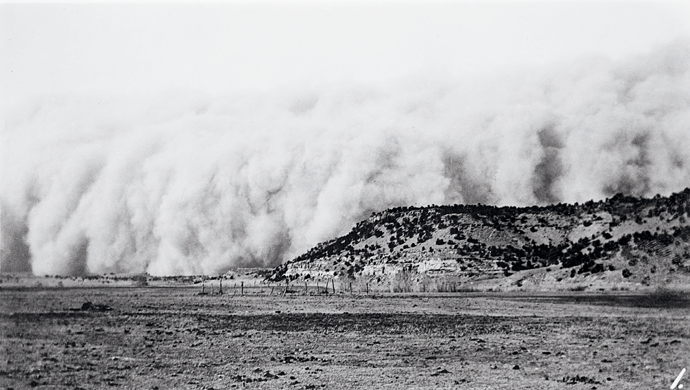
Dust storm, Baca County, Colorado, 1935 © J. H. Ward/LC-USZ62-47982
The devastation on the Plains seemed to throw all of nature out of balance. There were sudden inundations of green worms, then starving jackrabbits that swarmed out of the hills, darting eerily about. Towns advertised mass rabbit kills in the newspapers. Long lines of men, women, and children drove the screaming animals into pens, where they were finished off with axe handles. Before long, people were canning their meat to avoid starvation, eating them along with brined tumbleweed.
When birds and snakes all but disappeared from the Dust Bowl, they were replaced by a biblical plague of locusts, unseen in the West for decades, with as many as 14 million of the ravenous grasshoppers to a mile. At least one state government responded by sending out the National Guard to coat the land with up to 175 tons of insecticide per acre, thereby finishing off any life the drifting dirt or the grasshoppers might have left behind.
This was how things had always been done on our farms and pasturelands, a desperate capitalist battle, with every man for himself. If producing more crops drove down farm prices and wrecked the land, well, that was just how the market economy worked. There was always technology to fall back on, whether it was brand-new tractors to turn the dirt to the wind or insecticide to kill the locusts.
There had always been strong undercurrents of dissent, too. Some people, such as the Populists—the original Populists, not the vapid mobs that fill Trump rallies—argued that there was a better way. One of the most genuine grassroots organizations in American history, started by destitute farmers in the West and South, the Populist Party had built a movement of millions through the simple expedients of writing letters and sending out lecturers. In their mass rallies out on the prairies that were more like big community hootenannies, they preached solutions such as permanently stabilized crop prices, farm subsidies, collective bargaining, and agrarian co-ops. But these ideas were dismissed by politicians as socialist interventions into the “natural” economy of every man for himself. They started a sea change in American society, but the Populists themselves were relentlessly smeared as monetary cranks, anti-Semites, and barefoot hicks sucking on straws of grass. The price to be paid for ignoring their outlandish, “utopian” ideas would soon become plain.

A migrant worker camp, Harlingen, Texas, 1939 © Russell Lee/LC-DIG-FSA-8a25277
The Dust Bowl was the most frightening and most dramatic of the country’s ecological catastrophes in the 1930s, but it was far from the only one. The 1920s and 1930s produced some of the worst, and deadliest, floods in our history, many of them the result of bad farming habits and bad husbandry of the land. The collapse of the farm economy forced the failure of more than 750,000 family farms, and some 2.5 million Americans poured off the Great Plains in creaky old trucks and jalopies, most of them headed for California—“the first great migration of environmental refugees in the modern age,” as Collins has written. They were the Okies and Arkies and Exodusters, and they would become legend, but for the moment they were just broken people on the road who had left behind lifetimes worth of toil with nothing to show for it.
“There are many persons left today that can see no reason why if a man owns land he should not be permitted to do as he likes with it,” Franklin Delano Roosevelt wrote as a state senator in 1912—another insufferable New York upstart, just thirty years old and in his first term of elected office. FDR set property rights against what he called “the liberty of the community”:
I have taken the conservation of our natural resources as the first lesson that points to the necessity for seeking community freedom, because I believe it to be the most important of all our lessons.
Radical stuff, then as now, but the crucial contribution of the new president who took office in 1933 was to realize that it would all have to be dealt with as a piece, the land impossible to put back together until the people were made whole, and vice versa. It was one of FDR’s old-money pretensions to consider himself “a tree farmer” on his Hudson River estate, but he really did possess a deep instinct for considering communities—and even the country—as a whole, not just as unrelated capitalist components to be set against one another.
Making a speech to his neighbors at Hyde Park—most of them Republicans—at their annual Home Club meetings in that same “dirty” year of 1934, the president of the United States told them bluntly: “If a farm family is on the verge of starvation in North Dakota, we people in the town of Hyde Park are helping to pay to keep that family from actual starvation; if we have made mistakes in the settling of the country in the past, we in the town of Hyde Park have got to correct those mistakes. In other words, that we have a definite stake, not merely [in] the spiritual side of it, or the social side of it, or the patriotic side, but the actual financial side of it.”
Throughout the country, more than five hundred soil project stations would be set up, run by “Big Hugh” Bennett and his new Soil Conservation Service. Bennett was both a man of science and someone who had worked the soil all his life, unlike the crackpot railway promoters who had conned desperate farmers into ripping up the land. On the tired cotton farm in North Carolina where he was born and raised, Bennett saw firsthand how misuse of the soil had led it to give out. The “Father of Soil Conservation,” he was also a natural showman. While testifying before Congress on the necessity for his new agency, Bennett got word that another storm of “rolling black smoke” was headed for Washington and managed to stall the end of his testimony until it arrived.
As he finished, the congressmen rushed to the windows of the Capitol, watching as the duster “rolled in like a vast steeltown pall, thick and repulsive,” in the words of Bennett’s biographer. “The skies took on a copper color. The sun went into hiding. The air became heavy with grit.”
“This, gentlemen, is what I’m talking about,” Bennett told them. “There goes Oklahoma.”
The Soil Conservation Service became a reality, and its representatives went out into the heartland. It worked with the farmers where they were, assuming no region’s soil was like another’s, trying out promising new techniques such as terrace and contour farming. When the farmers of the Dust Bowl were unwilling to experiment, the Soil Conservation Service paid them to take part in the work to save their farms. Bennett would freely admit that “of all the countries in the world, we Americans have been the greatest destroyers of any race of people, barbaric or civilized”—but he never put the blame on individual farmers, who were forced into a battle for survival by a system in which they had so little say. Along with the men from the Agriculture and Interior departments, the federal government sent out boys from the Civilian Conservation Corps (CCC)—a huge new program created to absorb the thousands of destitute, homeless young men who had previously been riding the rails, living in hobo camps, and idling in cities, with nowhere else to go.
Many criticized this and other New Deal programs as socialist or fascist, but the CCC paid the three million young men it employed over the years thirty dollars a month (twenty-five of which they were required to send home to their families) and provided them with decent meals, a good place to sleep, education, exercise, and some training in woodcraft. In return, they planted thousands of acres of new buffalo grass and other, experimental drought-resistant grasses garnered from around the world. Before the program ended with World War II, they had also constructed more than eight hundred state parks and planted nearly three billion trees, many of them in the shelterbelts FDR had insisted upon, to tie down the soil. Together with Bennett’s experiments they had restored more than half of the damaged land by the time the war began.
The New Dealers also had the humility—for nearly the first time in white civilization on the continent—to admit the limits of the land, even in the face of technology. Thousands of farmers were settled permanently elsewhere, on farms and in cities and towns, moved away from a life that could not support them, and—with the assistance of government handouts and government workers—into places where they would become the unprecedented American middle class that emerged after World War II.
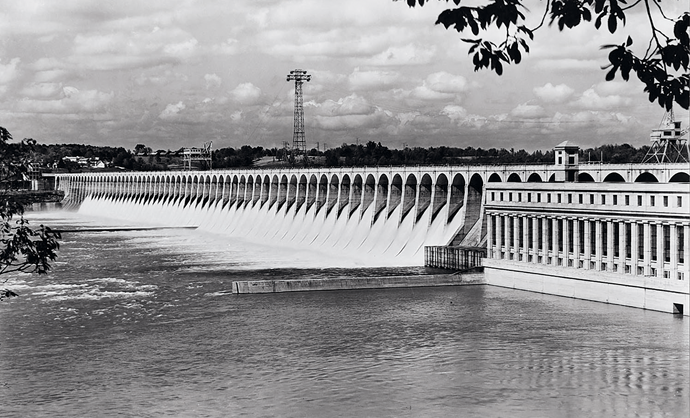
Wilson Dam, c. 1943. Courtesy the National Archives at Atlanta
These were vastly ambitious programs, but they did not fill the heart of Roosevelt, who wanted above all to build. The emergency of World War I had finally led the federal government to pay some attention to the potential of Muscle Shoals, for in America war is always the enabler that allows the consideration of any great project. The Wilson Administration had spent a total of $130 million to build two plants on the site to process nitrates for munitions and a hydroelectric dam to power the plants—only to see the war end before the dam was quite finished.
The Tennessee Valley Authority (TVA) was created in the first rush of New Deal legislation during Roosevelt’s Hundred Days, though a leading House Republican denounced it as “patterned closely after one of the Soviet dreams,” and the New York Times huffed that “enactment of any such bill at this time would mark the ‘low’ of Congressional folly.” Work on the TVA began almost immediately. By 1934 more than 9,000 men (and some women), many of them local hires, were working to design and construct the TVA—a number that swelled to nearly 40,000 by 1942. That same year they had under construction twelve hydroelectric plants and a steam plant. In all, forty-nine dams would be built, throughout six states, quickly making the TVA the largest hydropower construction project ever undertaken in the United States.
To this day, the TVA is the largest public utility in America, with 16,000 miles of transmission lines delivering 33,500 megawatts of power to almost 10 million customers. When it opened, it provided far and away the cheapest power in the country, setting a standard that drove down electrical rates everywhere. So infuriated were the private power companies that they twice tried to kill it with years-long lawsuits that went all the way to the Supreme Court before they failed.
The TVA was more than simply an effective works program or a cheap utility. Under the brilliant, ambitious David Lilienthal, one of a three-man board of directors, its benefits spread out over the region as swiftly as the floodwaters of the Tennessee River once had. New dams soon ranged across the waterways, sparkling jewels at night: the Fontana, the Hiwassee, the Douglas, and the Chickamauga—so impressive they provided an instant tourism industry, with a thousand people a day flocking to see the dams go up. Behind them sprung up a sports paradise of reservoirs, and nearly three hundred thousand acres of wildlife refuges, national parks and forests, recreational parks, and campsites.
In the years to come, the TVA would serve even more urgent and far-reaching purposes. Its dams and plants churned out vast amounts of munitions to help the war effort. The TVA also enabled the construction of the key atomic facility at Oak Ridge, Tennessee—part of the far-flung, nationwide Manhattan Project network that yielded the bombs that ended World War II. It was the TVA that powered the development of Huntsville, Alabama, first as a munitions center during the war, then as a key center for NASA. And after the war, it was the TVA that would power the full-scale industrial development of the New South, everything from the Muscle Shoals music scene to the auto plants and factories that transformed the Southeast United States.
Yet the Tennessee Valley Authority was never just about providing construction jobs, or even powering new industries in the region, as long-lasting and beneficial as those changes would be. The TVA also started the Electric Home and Farm Authority (EHFA), to ensure that all those dams would have something to power. EHFA provided the low-cost financing that enabled local residents to purchase electric stoves, refrigerators, lamps, irons, water heaters, and water pumps. Almost overnight, the people of the Valley had caught up to the basic amenities of life enjoyed by so many of their fellow Americans in towns and cities.
The nitrate plants also produced fertilizer, distributed free in order to rebuild the soil. The Forest Service and the CCC replanted the woodlands, and Bennett’s soil conservation crews also convinced the region’s farmers to rotate crops, and shared new farm implements and agricultural techniques with them. The Army Corps of Engineers cut a channel around the devil’s fist, making the entire length of the Tennessee navigable for the first time. In less than two decades, from 1933 to 1952, river traffic rose from 32 million to more than 800 million ton-miles. Most important of all, the US Public Health Service wiped out malaria and most of the other diseases in the Valley, and extended the lives of countless women by finding them proper prenatal and birth care.
Not everything the TVA did was a smart idea, particularly from our modern perspective. Seeking to meet the exponentially expanding power needs of the region—needs it largely created—after World War II, the TVA built ten fossil-fuel power plants and planned to erect seven nuclear power plants. But four of the fossil-fuel plants have been phased out, and four of the nuclear plants were scrapped before they opened—replaced in part by the fifteen solar-power facilities and a wind-power plant the TVA operates. The Oak Ridge National Laboratory is a major science and technology research center. Huntsville’s old NASA facilities have become a biotechnology hub.
Few if any conservationists today would endorse the TVA’s—or the old New Deal’s—unabashed enthusiasm for dams, considering what we know now about their effect on entire ecosystems. There were, as well, the human costs that today’s Green New Dealers, to their credit, would not countenance. But an executive order from President Roosevelt, in May of 1935, did secure the opening of public-works jobs to people of all races, and other federal programs such as the Resettlement Administration (later the Farm Security Administration) enabled many black farmers to escape the bondage of sharecropping in the region. Altogether, the TVA moved fifteen thousand families off the land to new farms and towns, drowning under reservoirs the homesteads and tiny villages where these families had lived for generations—another indignity that the Green New Deal, with its insistence on respecting poor communities, would likely hesitate to embark upon.
The cries of socialism continued to fly, with accusations that the TVA had precluded all sorts of private developments that somehow had never materialized until the federal government started building at Muscle Shoals. Nevertheless, the TVA remained so popular throughout the country that General Electric is supposed to have censored its spokesman Ronald Reagan for criticizing it in 1962. Barry Goldwater’s offhand remark, “You know, I think we ought to sell the TVA,” inspired Lyndon Johnson to construct an entire ad in the 1964 campaign around the pledge, “This is a promise: President Johnson will not sell the TVA.”
The TVA did not create a utopia. But once such a structure has been put into place, one that considers an area’s human needs and aspirations, almost any number of useful things, even those not planned, may occur. Mistakes can be corrected, wind power can replace coal, people can start over after disasters. Call these projects economic multipliers if you will, but they are more than purely economics.
The final grace note the TVA added to tie the Valley together was one provided by a middle-aged librarian, feminist, and historian who lived almost her entire life in the area. When the authority found that its workers had few diversions in a region largely devoid of movie theaters, radio stations, or even newspapers, it asked Mary Utopia “Topie” Rothrock, a redheaded, Presbyterian minister’s daughter, to become its director of library services.
Topie Rothrock accepted the challenge and was soon circulating thousands of books a month, setting up makeshift libraries in the backs of general stores, post offices, filling stations—anyplace she could. “Wherever they live or work, the library follows,” Topie insisted.
Soon after, with the help of a strong lobbying push from Lilienthal, permanent libraries replaced the temporary ones, in places where few children had ever seen a book before. It was the completion of a community.
“It could be Tennessee Valley Authority–style public programs, but it could also be public-private partnerships. It can work down on a municipal level. There could be some potential contracting involved. So it’s not as though the federal government’s going to wave a wand and say, ‘We’re going to do it all ourselves,’” Representative Alexandria Ocasio-Cortez said soon after announcing the Green New Deal.

Works Progress Administration (WPA) poster encouraging the planting of trees for soil conservation, 1940, by Joseph Dusek. Courtesy Library of Congress, Prints and Photographs Division.
It was a statement both nuanced and knowledgeable—and one that was greeted with a reaction so vituperative, so personal and silly, so outraged and unrelenting as to suggest that she had hit a nerve very deep in the nation’s power structure.
Coming from the right, the blowback was predictable, and predictably stupid: the Democrats want to ban cows and planes and your SUV, and go right to “war socialism.” A group funded primarily by the Mercer family even rented a billboard in Times Square—placed, without a scintilla of irony, just above Ripley’s Believe It or Not! and near Madame Tussauds wax museum—that blamed Ocasio-Cortez for the sin of spoiling Amazon’s publicly subsidized move on Long Island City.
More surprising, perhaps, was how much anger the Green New Deal stirred in the center of what passes for respectable, moderate—and even liberal—opinion in America today. The Ocasio-Cortez resolution is a “fantasy” manifesto that “threatens to destroy workers’ livelihoods” and “increase divisions and inequality,” claimed labor leader Terry O’Sullivan. It was the “empty sloganeering” of “people who believe capitalism is the root of all problems,” according to New York magazine’s Jonathan Chait. The Green New Deal will lose the support of “too many workers with impractical, unrealizable objectives. We will jeopardize what has been, I think, the very significant movement of the large energy companies toward developing their new business models to function in a low-carbon world,” warned Barack Obama’s former energy secretary, Ernest Moniz, now a board member with a private energy giant.
“There’s no way to pay for it,” and climate change is “not gonna get turned around in ten years,” scoffed Senator Dianne Feinstein in her now infamous viral video telling off a group of uppity schoolkids who dared to come to her office in support of the resolution. “The green dream or whatever they call it, nobody knows what it is, but they’re for it, right?” was how House Speaker Nancy Pelosi waved it away, while Dick Durbin, the Democratic Senate minority whip, pretended on Joe Scarborough’s MSNBC show that he could not even comprehend it, asking the resolution’s cosponsor, Senator Ed Markey of Massachusetts, “What in the heck is this?”

WPA-inspired Green New Deal poster by Loveis Wise for Harper’s Magazine
It’s the future, Dick, if we’re going to have one. But the whole idea left one Establishment columnist after another badly shaken. The New York Times’ Thomas Friedman even refused to believe that a passing phrase hoisted from a working staff document that mentioned helping even those “unwilling” to work did not reflect the true commie intentions of AOC and her Green New Dealers—a smear repeated in a Sunday Times editorial a few days later. The Paper of Record scourged the congresswoman and her staff for having let leak “pugnacious and poorly written talking points (later disavowed) that scared even moderate Democrats, and
dismissed as unacceptable three strategies that many experts say are necessary to any solution: nuclear power; technology that allows fossil fuel plants to capture and store their own emissions, and market-based solutions like a carbon tax or . . . cap and trade.
The Times’ bottom line?
Is the Green New Deal aimed at addressing the climate crisis? Or is addressing the climate crisis merely cover for a wish-list of progressive policies and a not-so-subtle effort to move the Democratic Party to the left? At least some candidates—Amy Klobuchar of Minnesota among them—seem to think so. Read literally, the resolution wants not only to achieve a carbon-neutral energy system but also to transform the economy itself.
The answers to these questions are yes and yes. We must address climate change, and we must transform the way our political and economic systems work in this country—just as we did during the Great Depression. There is no way to do one vital thing without doing the other. The political establishment, even within the Democratic Party, doesn’t seem to understand this, any more than the congressmen listening to Hugh Bennett understood the urgency of the moment until they looked out the windows of the Capitol and watched Oklahoma blowing by.
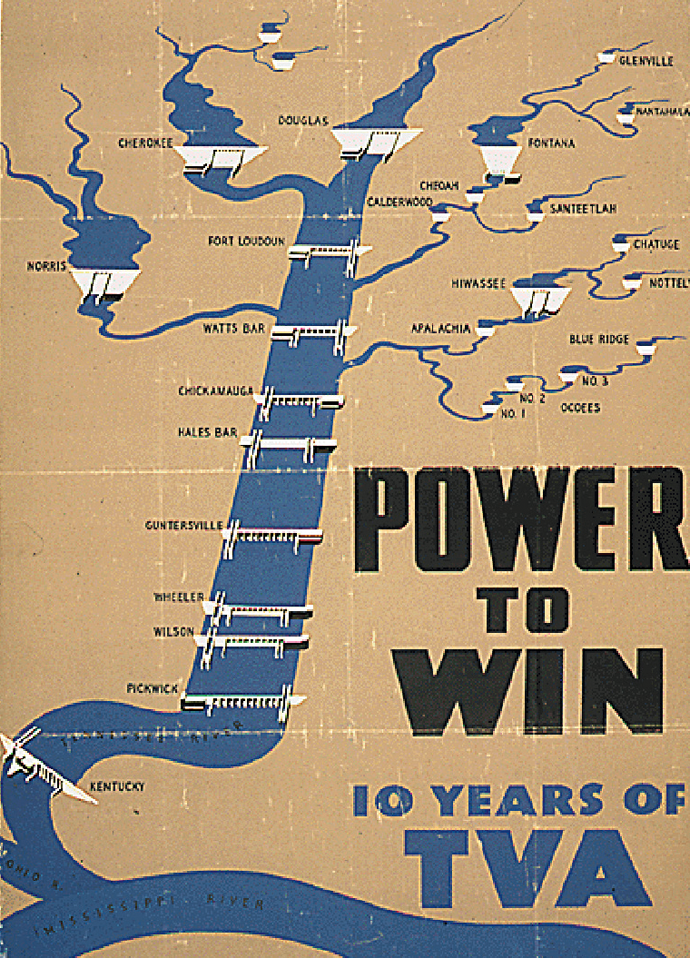
Office of War Information poster, artist unknown, c. 1942–1945
“The better model,” Jonathan Chait tells us, is “building on and scaling up Obama’s successful green reforms”—never mind that the former president’s reforms, woefully inadequate in the first place, have now largely been squashed by President Trump.
“We have got to meet folks where they are. . . . I don’t always lead with the climate change issue because if you right now are worried about whether you’ve got a job or if you can pay the bills, the first thing you want to hear is how can I meet the immediate problem?” President Obama told Friedman midway through his second term, explaining why he did so little in the end. “One of the hardest things in politics is getting a democracy to deal with something now where the payoff is long-term or the price of inaction is decades away.”
But this misses the point—or really, all the points—about addressing climate change. Part of responsible leadership is alerting people to looming problems and rallying them to do something—and in this crisis, as in so many, much less would have needed doing if we had done it sooner.
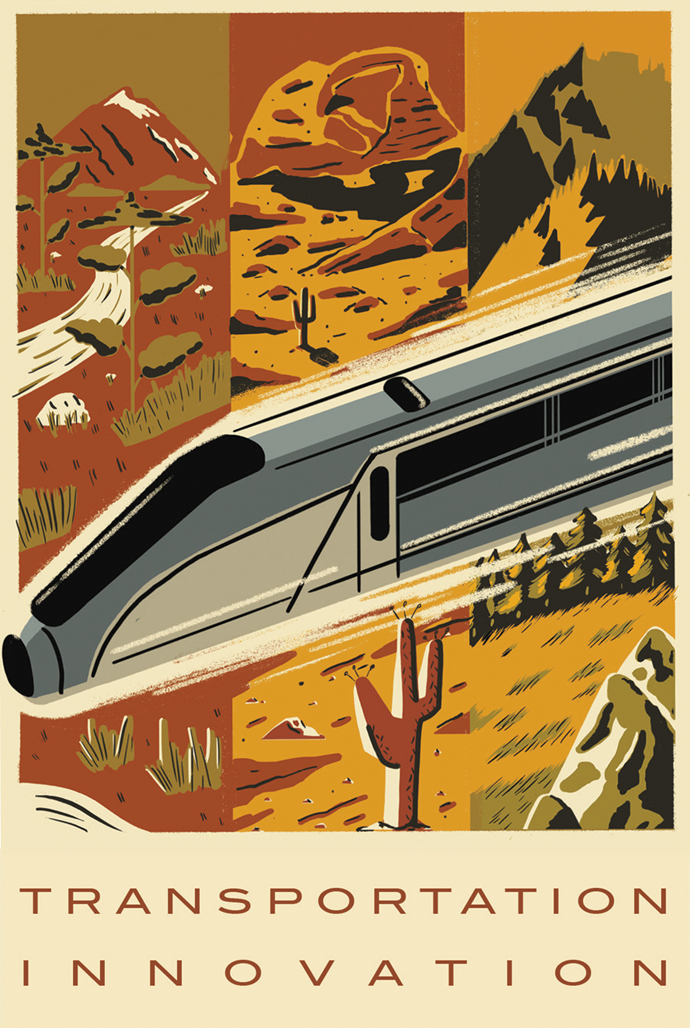
WPA-inspired Green New Deal poster by Kevin Whipple for Harper’s Magazine
When the federal government realized, more than a hundred years before the Dust Bowl, that much of the Great Plains did not have enough water to support standard, Eastern agriculture, the right thing to do was not to acquiesce in the Big Railroad lies about rain following civilization because that was what struggling farmers wanted to hear. We have known that man-made, preventable climate change is happening for a long time. Scholars have been predicting global warming in some form since the nineteenth century; Alexander Graham Bell, perhaps the most revered scientist in America at the time, wrote on the subject in 1917. Edward Teller, the “father of the hydrogen bomb,” famously warned oil executives about climate change in the late 1950s, and President Lyndon Johnson’s science advisory committee issued a report highlighting the potential dangers in 1965. James Hansen’s five-alarm testimony before Congress came in 1988, and Al Gore’s Oscar-winning documentary, An Inconvenient Truth, came out in 2006. “Decades away,” Mr. President? Our discovery of climate change is now decades behind us, and still we do nothing.
We have increased the temperature of the earth by nearly 1 degree Celsius since the 1880s, which has led to climate events of unprecedented frequency and ferocity, including terrible fires, hurricanes, the decline and extinction of entire species, and dire food and water shortages that have precipitated wars and refugee crises. We are headed rapidly toward doubling that increase to 2 degrees, which could kill off the world’s coral reefs, melt enough global ice to flood every city by a seashore, and turn “the biggest cities of the Middle East and South Asia . . . lethally hot in summer,” according to the climate journalist David Wallace-Wells writing in a New York Times article headlined time to panic.
What will happen when we get to a 3-degree, or 4-degree, or 6-degree increase—all incredibly likely, if we continue to do nothing—is so terrible as to be beyond useful contemplation. Suffice it to say, those temperatures will destroy us.
To stay below a 2-degree increase we will have to cut back global carbon emissions by a whopping 45 percent by 2030. Whereas if we had started doing something about this back in 2000, according to a Global Carbon Project analysis cited by Wallace-Wells, we would have had to cut back on carbon emissions by only about 2 percent a year.
Another part of leadership is reacting effectively to emergencies that nobody saw coming. The sclerotic leadership of the Democratic Party and the ponderous scolds at the New York Times speak to the fierce urgency of someday, maybe. But in the present emergency, the truly delusional are those who believe we can go on doing business as usual.
The Green New Deal’s ideas to stop and reverse global warming—primarily by decarbonizing the US economy “as much as technologically feasible” through massive investments in renewable energy, a smart electrical grid and increased energy efficiency; ubiquitous public transportation; and making low-tech advances in sustainable agriculture, adding forests, and restoring ecosystems—are entirely practical because this is what has to be done if we are to survive on this planet. They are in line with what we have done before, when we had to.
The solutions cannot be allowing power companies to determine just how much carbon they are recapturing, or trying to lure businesses with this or that tax incentive, or—most absurd of all—littering the landscape with nuclear-fission plants, ticking time bombs that take years to build, excrete eternally poisonous waste, and will be fought tooth and nail by everyone forced to live in their vicinity. Moving to a green economy is not going to somehow prevent the unionized, high-paying factory jobs of 1955 from magically reappearing. They’re gone for good. No one is going to rally around a plucky band of environmental moderates led by Amy Klobuchar. There is no grand, bipartisan coalition to be had with Republicans, who as a matter of faith refuse to believe in man-made climate change, and who have brought us a president and an administration actively doing everything they can to make global warming worse.
What’s more, the social and economic ideas proposed in the Green New Deal are also significantly more practical than the alternatives pushed forward by the moderates. Let’s be clear about what we mean here: the guarantee of a decent, well-paid job; a first-rate, free education through college; some form of universal health care; a retirement into comfort and dignity; trade deals that serve our whole society; clean air and water, and food that doesn’t spur our deaths; and real help for minorities, the poor, and Native Americans, and consultation with them over what is to happen to their neighborhoods and lands.
Every one of these proposals was achieved long ago elsewhere in the developed world, or has been here in the past, or is something we have always dreamed of having. The Humphrey–Hawkins Full Employment Act passed over forty years ago. A 70 percent top income tax bracket? The top bracket used to be 90 percent, back in the boom years of the late 1940s and early 1950s.
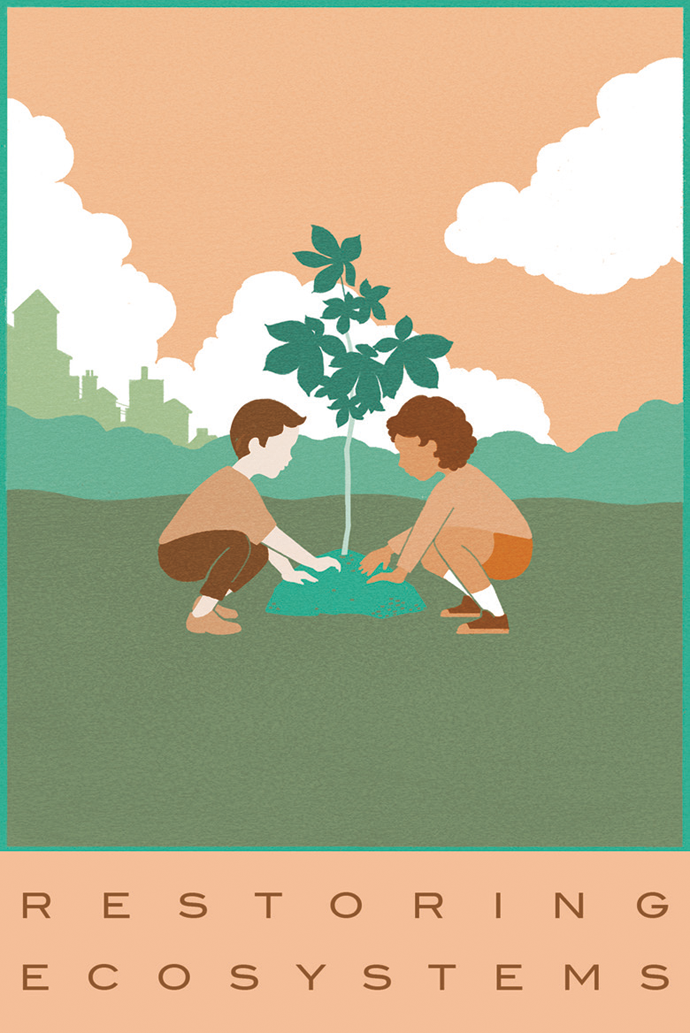
WPA-inspired Green New Deal poster by Julia Kuo for Harper’s Magazine
Objections such as “how can we ever afford it?” are frankly obscene at this point in our history. How can we afford it? Maybe by holding back a bag or two of the gold we now all but hurl at the rich. Maybe we don’t offer a $3 billion incentive to Jeff Bezos to move his company of warehouse slaves into a neighborhood already filling up daily with skyscrapers full of “knowledge workers.” Maybe we cut back a tad from our 800 military bases around the world and a $686 billion defense budget that equals the rest of the planet’s combined?
In a country this wealthy, and with so much of its wealth being blatantly misappropriated or stolen, how we will pay for making our fellow citizens healthier, smarter, and richer is simply not a serious question. The social and economic reforms of the Green New Deal are what we were once moving toward as a society, what we should have been moving toward all along.
“It says to Americans: we are going to do something really big, fast, disruptive, and ambitious, but during the transitions you will not be left behind or forgotten,” David Roberts wrote in Vox this February.
You will be able to find a job and a role to play; you will not be threatened with homelessness or lack of health care. We are going to do this big thing together, all of us, and through it we will lift each other up.
Roberts’s analysis points the very pragmatic way to electoral victory as well. Think the Green New Deal is frightening or unrealistic? Take a look at the moderate alternative for the future:
What if I am a steelworker in Pittsburgh and in the union, but on weekends I drive for Uber and rent out my kid’s spare bedroom on Airbnb—and shop at Walmart for the cheapest Chinese imports, and what I can’t find there I buy on Amazon through a chatbot that replaced a human?
Thomas Friedman speculated, not so coincidentally in the same column in which he denounced Ocasio-Cortez as a lunatic utopian. (Friedman has repeatedly suggested that Airbnb is leading the way to a “sharing economy” in which people might start restaurants in their homes. And that this is a good thing.)

WPA poster for the National Park Service, 1940, by Frank S. Nicholson. Courtesy Library of Congress, Prints and Photographs Division
The reality, of course, is that most of the unionized steelworkers left Pittsburgh decades ago, and that Uber and many other driving jobs—which employ some 5 million Americans—will likely be gone as well in at least another ten or twenty years, if not sooner, with the rise of the self-driving car and truck. For all those unable—or unwilling—to set up a sous-chef in the baby’s room, the problem facing us is going to be finding enough work—or a guaranteed national income—for all.
What’s telling is that all of our irritated politicians and pundits seem most upset by the possibility that people might not go on working at the frenzied pace our Western economy now demands. What they promise is only the acceleration of mindless toil and more things to make up for the things that have failed: nuclear reactors and “clean coal,” and who knows what other marvels as the floodwaters rise, and the winds howl, and the land burns. Massive dikes and levees? Desalination plants, recycled wastewater, and homes that are built like bunkers?
The possibilities are endless, which is why our leaders are not really worried about climate change itself, only the possibility that it might spur real social and economic change. What they promise us is, quite literally, business as usual, and nothing but business. It doesn’t matter how defiled the earth or our life on it becomes, just that there will still be something to market and sell.
“Our Gross National Product . . . counts air pollution and cigarette advertising, and ambulances to clear our highways of carnage,” Robert F. Kennedy said in a famous speech at the University of Kansas a few months before his death.
It counts special locks for our doors and the jails for the people who break them. It counts the destruction of the redwood and the loss of our natural wonder in chaotic sprawl. It counts napalm and counts nuclear warheads and armored cars for the police to fight the riots in our cities. It counts Whitman’s rifle and Speck’s knife, and the television programs which glorify violence in order to sell toys to our children.
Kennedy’s words seemed obvious at the time, even trite. But their relevance hits home today, more than half a century later, as we approach the dead end of our purely commercial approach to life on this planet. Herein lies the simple underlying brilliance of the Green New Deal: the acknowledgment that we cannot go on as we have, not only in degrading the earth but also in degrading each other, through the existing economic system we have allowed to overrun us.
“[T]here are virtues in trying to offer not just a technical blueprint but a comprehensive vision of the good society, and virtues as well in insisting that dramatic change is still possible in America, that grand projects and scientific breakthroughs are still within our reach,” conservative columnist Ross Douthat mused after a generally critical look at the Green New Deal proposals.
[T]he desire not to be a decadent society is a healthy one, and in that sense the Green New Deal deserves credit for looking at the American past and saying, in effect: Why not us, again?
Like the best of liberalism, which was what the original New Deal was—and the Green New Deal could be—the proof is in the doing. All the efforts to dismiss it as some socialist plot will not stand, cannot stand, if we are to meet the greatest challenges of our time. Those challenges will not vanish just because we want to avoid them. They will not slow just because we prefer to go slow. The Green New Deal, as its name implies, is meant to be a restoration, a return to the sort of fairness, the human balance, the dignity of a working life wantonly abandoned and derided by so many of our leading politicians and commentators. If we are to survive, it will be necessary to ignore them. Obviously, they have nothing more to offer.
The manifesto that announced the Green New Deal will not be instituted literally. Some parts of it will be compromised, some will be improved, added, or subtracted. But it had better come into being, or we will leave to future generations a world of natural disasters unlike anything we have ever known.
No doubt it will be a heavy lift. But there is one, somewhat comforting fact to remember as we face the task ahead of us: we have been here before.






























































































